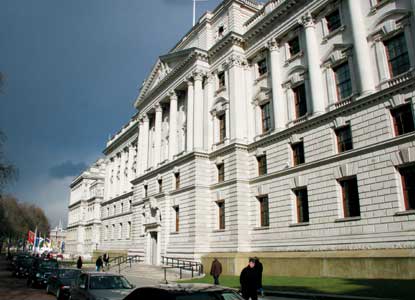Around £48bn of spending cuts or tax increases are needed to put the government’s deficit reduction plan back on track, a report by two think-tanks revealed today.

In an analysis of the public finances ahead of the Chancellor’s Autumn Statement next month, the Social Market Foundation and the Royal Society of Arts said the ‘black hole’ was larger than previously thought.
Chancellor George Osborne’s 2010 Spending Review intended to reduce spending over the four-year period to eradicate the structural deficit by the end of 2014/15. But weak economic growth meant he had to extend the spending cuts into the next Spending Review period. In the March Budget , he estimated that a further £26bn would be needed in cuts or tax rises to close the deficit within the next five years.
Following the recession in the first six months of this year, this figure needs to be increased by £22bn, according to the think-tank reportFiscal fallout. It says government borrowing this year is likely to be higher than the Office for Budget Responsibility’s forecast, and the structural deficit is 1.1% of gross domestic product larger than expected in March.
Using the same model as the OBR, SMF director Ian Mulheirn concluded that the government would miss the target to eliminate the structural deficit within five years unless it announced deeper cuts in the three years to 2017/18.
Annual real-terms cuts to most departmental spending of 3.7% between 2015 and 2018 would be needed – more than the average 2.3% in cuts over the current Spending Review, he said.
‘According to the OBR’s own models, the economy appears to have less room to bounce back than previously thought. Combined with high public borrowing since March, this implies a much bigger black hole in the public finances, making the stakes for the next Spending Review higher than ever,’ Mulheirn added.
‘Combined with the savings pencilled in at the last Budget, the developments since March means that the chancellor will have to lay out some eye-watering cuts at the next Spending Review and will prolong austerity deep into the next Parliament. Looking across the decade, the combined effect of the 2010 Spending Review, and the next one will, on current plans, mean that by 2018 spending in some departments will have been decimated.’
The RSA’s section of Fiscal fallout warns ministers that they will not be able to keep ‘salami-slicing’ budgets at government departments. It says the next review should instead explore a radical remodelling of public service provision to promote ideas like the Living Wage and localised spending on growth.
RSA chair of public services Ben Lucas added: ‘Faced with the unprecedented level of cuts to public spending outlined by the SMF, we can’t continue to tinker around with a model of public services that was designed in the 1940s. What’s needed is a radical new approach based on social productivity which moves away from Whitehall towards local-based collaboration, integration and shared services.’



















